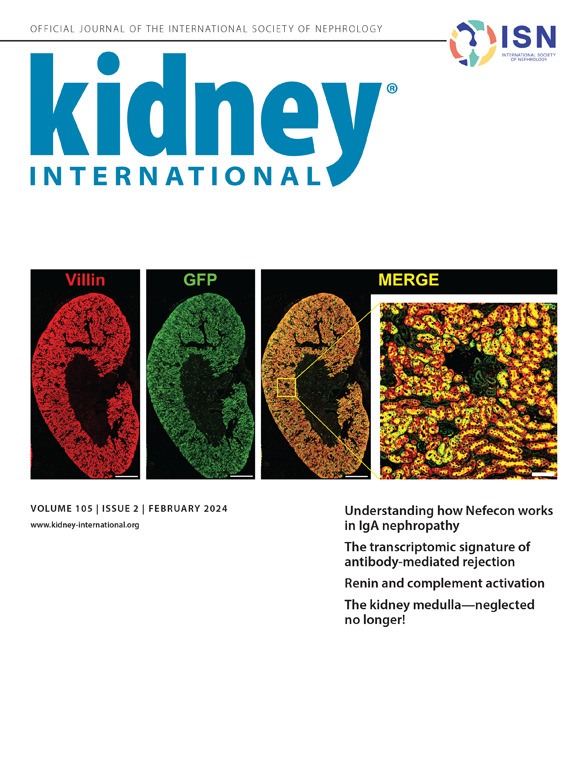一项全国性的基于登记的队列研究调查了母亲先兆子痫与其后代患肾病的风险之间的关系。
IF 12.6
1区 医学
Q1 UROLOGY & NEPHROLOGY
引用次数: 0
摘要
先兆子痫妇女经常早产(妊娠37周以下)。早产与后代肾脏疾病风险增加有关,但子痫前期是否与肾脏疾病风险独立相关尚不清楚。在这里,我们进行了一项基于登记的队列研究,以探讨在考虑早产后母体子痫前期与后代肾脏疾病之间的关系。方法使用Cox回归,我们估计风险比(hr),比较有和没有暴露于母体先兆子痫的后代总体和按亚型的肾脏疾病发病率。结果该研究纳入了1978-2017年出生在丹麦的2288589人,其中63191人暴露于先兆子痫;在43137193人年的随访期间,37782人患上了肾脏疾病。暴露于子痫前期和足月出生(妊娠37周以上)的后代比足月出生但未暴露于子痫前期的后代在婴儿期发生肾脏疾病的可能性高26% (HR 1.26, 95%可信区间[1.09-1.46]),并且在1岁后除急性肾脏疾病外,所有肾脏疾病亚型的发病率都增加(HR范围1.11至1.88)。足月子痫前期与后代慢性肾病、未明确肾病和糖尿病肾病的相关性在25岁后最强(hr分别为1.36、1.70和2.85)。相反,几乎没有证据表明早产的子痫前期暴露与出生后1年以上后代肾脏疾病发生率增加有关(1岁以下:1.41,[1.05-1.90];一年或一年以上:0.94,[0.79- 1.11])。结论母体足月先兆子痫与子代肾脏疾病的关联提示其潜在机制不同于那些可能解释与早产相关的机制。本文章由计算机程序翻译,如有差异,请以英文原文为准。

A nationwide register-based cohort study examined the association between preeclampsia in mothers and the risk of kidney disease in their offspring
Introduction
Women with preeclampsia often deliver preterm (under 37 weeks of gestation). Preterm birth is associated with an increased risk of offspring kidney disease, but whether preeclampsia is independently associated with kidney disease risk is unknown. Here, we conducted a register-based cohort study to explore associations between maternal preeclampsia and offspring kidney disease after accounting for preterm birth.
Methods
Using Cox regression, we estimated hazard ratios (HRs) comparing kidney disease rates, overall and by subtype, in offspring with and without exposure to maternal preeclampsia.
Results
The study included 2,288,589 persons born in Denmark 1978-2017 of whom 63,191 were exposed to preeclampsia; 37,782 individuals developed kidney disease during 43,137,193 person-years of follow-up. Offspring exposed to preeclampsia and born at term (37 or more weeks’ gestation) were 26% more likely than offspring born at term but not exposed to preeclampsia to develop kidney disease in infancy (HR 1.26, 95% confidence interval [1.09-1.46]), and had increased rates of all kidney disease subtypes except acute kidney disease after one year of age (HR range 1.11 to 1.88). Associations between term preeclampsia and offspring chronic, unspecified, and diabetic kidney disease were strongest after 25 years of age (HRs 1.36, 1.70 and 2.85, respectively). Conversely, there was little evidence that exposure to preeclampsia with preterm delivery was associated with increased rates of offspring kidney disease beyond the first year of life (under 1 year: 1.41, [1.05-1.90]; one year or more: 0.94, [ 0.79- 1.11]).
Conclusions
Associations of maternal term preeclampsia with offspring kidney disease hint at underlying mechanisms different from those potentially explaining established associations with preterm birth.
求助全文
通过发布文献求助,成功后即可免费获取论文全文。
去求助
来源期刊

Kidney international
医学-泌尿学与肾脏学
CiteScore
23.30
自引率
3.10%
发文量
490
审稿时长
3-6 weeks
期刊介绍:
Kidney International (KI), the official journal of the International Society of Nephrology, is led by Dr. Pierre Ronco (Paris, France) and stands as one of nephrology's most cited and esteemed publications worldwide.
KI provides exceptional benefits for both readers and authors, featuring highly cited original articles, focused reviews, cutting-edge imaging techniques, and lively discussions on controversial topics.
The journal is dedicated to kidney research, serving researchers, clinical investigators, and practicing nephrologists.
 求助内容:
求助内容: 应助结果提醒方式:
应助结果提醒方式:


